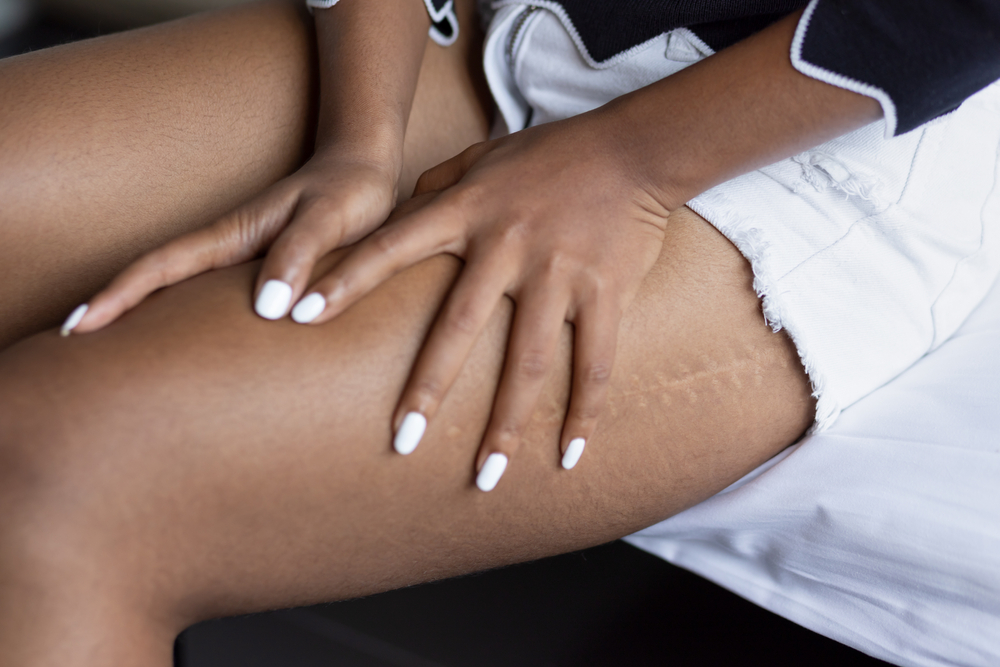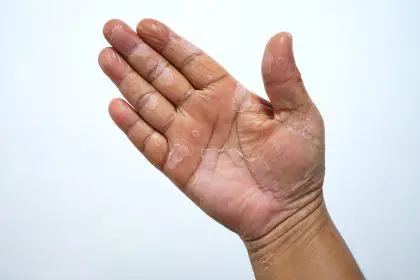You got a tiny cut or a pimple, and instead of healing into a barely visible mark like everyone else, your skin decided to throw a tantrum and create a raised, angry scar that keeps growing like it’s got a personal vendetta against you. What started as something minor has turned into a thick, rope-like monster that spreads beyond the original wound and refuses to calm down no matter how much time passes.
If this scenario sounds painfully familiar, welcome to the world of keloids, where your genetic code has essentially programmed your skin to be a total overachiever in the worst possible way. These aren’t just bad scars or signs that you didn’t take care of a wound properly. Keloids are what happens when specific genes tell your healing process to go completely haywire and produce way too much scar tissue without knowing when to stop.
Understanding why your body creates these excessive scars while your friends heal with barely a trace requires diving into the genetic lottery that determines whether you’re destined for smooth healing or scar chaos. The truth is, your DNA holds the blueprint for how your skin responds to injury, and for some people, that blueprint includes instructions for creating scar tissue that just won’t quit.
Your cells got programmed to never stop healing
Think of normal wound healing like a construction project with a clear timeline. Your body sends in the repair crew, they patch up the damage, clean up the worksite, and head home once the job is done. But when you’re genetically prone to keloids, it’s like your construction crew never got the memo that the project is finished, so they just keep building and building until you have a massive structure where a simple repair should have been.
The genetic variations that cause keloid formation primarily affect your fibroblast cells, which are the workers responsible for producing collagen during healing. In people with keloid susceptibility, these cells go into overdrive when the skin is injured, pumping out excessive amounts of collagen long after the original wound has closed and healed.
These genetic differences are so powerful that they can override all your best intentions for proper wound care. You can follow every healing protocol perfectly, keep wounds clean and protected, and still end up with keloids because your genes are calling the shots in your cellular healing response.
Your ancestry predicts your scar destiny
Here’s where genetics gets really interesting, and potentially frustrating. Keloid susceptibility isn’t distributed equally across all populations. If you’re of African, Hispanic, or Asian descent, you’re playing genetic roulette with significantly worse odds than people of European ancestry. Some estimates suggest that African Americans are up to 15 times more likely to develop keloids than Caucasians.
This isn’t about lifestyle differences or environmental factors. There are specific genetic variations that are more common in certain ethnic groups, variations that essentially program your skin to produce excessive scar tissue when injured. These genetic differences likely evolved as adaptations to different environmental conditions thousands of years ago, but they create problems in our modern world where people are more likely to have surgeries, piercings, and other intentional skin injuries.
The family connection is incredibly strong too. If one of your parents develops keloids, your chances of developing them shoot up dramatically. Some families have multiple members who struggle with keloid formation, while others seem completely immune to the condition regardless of how many cuts, scrapes, or surgeries they experience.
When your genes team up with hormones
Your genetic predisposition to keloids doesn’t exist in a vacuum. Hormones act like fuel on the genetic fire, which explains why keloids most commonly appear during periods of hormonal upheaval like puberty, pregnancy, and perimenopause. Estrogen and other hormones seem to stimulate the cellular processes involved in keloid formation, turning your genetic susceptibility into active scar production.
This is why many people first notice keloids during their teenage years, or why pregnant women might develop them for the first time even if they’ve never had problematic scars before. Some women find that their existing keloids grow larger or become more symptomatic during pregnancy, as if the hormonal changes are feeding the scar tissue.
Your body’s geography determines scar risk
Even if you’re genetically prone to keloids, not all areas of your body are equally likely to develop them. Your chest, shoulders, back, and earlobes are like prime real estate for keloid development, while your palms, soles of your feet, and other areas rarely develop keloids even in highly susceptible people.
The difference comes down to mechanical stress and skin tension. Areas that experience constant pulling and stretching from normal body movement seem to trigger and worsen excessive scar tissue formation. Your chest expands and contracts with breathing, your shoulders move with every arm motion, and your earlobes get tugged by earrings and pillows during sleep.
This geographical risk pattern means that people with keloid susceptibility can sometimes avoid problems by being strategic about where they allow skin trauma to occur. Getting a piercing on your earlobe might be asking for trouble, while a small cut on your palm might heal normally even in someone who’s highly keloid-prone.
Location also affects treatment success
Interestingly, keloids in different locations respond differently to treatment approaches. Keloids on the chest and shoulders tend to be more aggressive and harder to treat than those in other areas, possibly because of the constant mechanical stress these areas experience. This means that prevention becomes even more critical in high-risk body zones.
Understanding your personal risk geography can help you make informed decisions about elective procedures like tattoos, piercings, or cosmetic surgeries. If you know you’re genetically susceptible to keloids, avoiding unnecessary trauma in high-risk areas becomes a crucial part of managing your condition.
Prevention beats treatment every single time
If you’ve won the genetic lottery for keloid susceptibility, your best strategy is avoiding unnecessary skin trauma whenever possible. This means being incredibly selective about elective procedures like cosmetic piercings, tattoos, or surgeries that aren’t medically necessary. Even minor skin injuries can trigger keloid formation in susceptible people.
The definition of “minor” changes dramatically when you’re genetically prone to keloids. Aggressive acne treatment, harsh scrubbing, picking at scabs, or using irritating skincare products can all provide enough trauma to trigger excessive scar formation. Being gentle with your skin and allowing wounds to heal naturally without interference becomes a crucial lifestyle consideration.
When you do need medical procedures or suffer accidental injuries, working with healthcare providers who understand keloid risk can make a huge difference. Surgeons who are experienced with keloid-prone patients can use specific techniques during wound closure that reduce the likelihood of problematic scar formation.
Early intervention can change everything
If you’re prone to keloids and experience a skin injury, how you care for the wound in the first few weeks can significantly influence whether a keloid develops. Keeping wounds moist, protected, and under appropriate pressure can help guide the healing process toward normal scar formation rather than keloid development.
Silicone gel sheets or silicone gel applied to healing wounds have shown promise in reducing keloid formation, though they need to be used consistently for several months to be effective. Some people benefit from corticosteroid injections into healing wounds or new scars, but this needs to be done by experienced healthcare providers who understand the timing and techniques that work best for keloid prevention.
Living with genetic scar susceptibility
Once you understand that your keloid tendency is genetic rather than a personal failing or sign of poor wound care, you can develop realistic strategies for managing your risk while still living a full life. This might mean avoiding certain activities, being extremely careful about skincare routines, and making informed decisions about medical and cosmetic procedures.
The key is accepting that your genetic makeup requires a different approach to skin care and wound healing without letting keloid risk prevent you from necessary medical care or important life activities. Some people find that working with dermatologists or plastic surgeons who have specific experience with keloid-prone patients helps them develop personalized strategies for managing their risk.
Support groups and online communities can be incredibly valuable for people dealing with significant keloid susceptibility. Sharing experiences and learning from others who understand the challenges of living with genetic scar predisposition can provide both practical advice and emotional support.
Treatment options are improving but still limited
Unfortunately, once keloids have formed, they’re notoriously difficult to treat effectively. Traditional approaches like surgical removal often make keloids worse because the surgery itself creates new trauma that can trigger even larger keloid formation. It’s like trying to fix a fire by adding more fuel.
Current treatment approaches focus on reducing inflammation and preventing further growth rather than completely eliminating existing keloids. Corticosteroid injections, laser therapy, radiation treatment, and newer techniques like cryotherapy can help flatten and soften keloids, but results vary significantly between individuals and depend heavily on the location and characteristics of the specific keloids being treated.
Research into new treatments is ongoing, with promising approaches including targeted drug therapies that interfere with the cellular processes involved in keloid formation. As scientists better understand the genetic mechanisms behind keloid development, more effective treatments may become available for people whose genes have programmed them for excessive scar formation.















